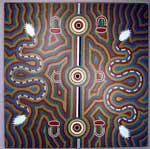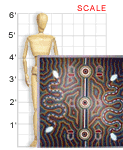VAM galleries including this work:
The Owensboro Museum of Fine Art | Do You See a Pattern? | Young at Art || VAM Home
Pamela Lynch Kngwarreye (Aboriginal Australian)
CORROBOREE DANCE DREAMING, 1989
Acrylic on canvas; 48" X 48"
A Gift of William E. and Susanne Waites
Collection of Owensboro Museum of Fine Art
Corroboree Dance Dreaming is an Aboriginal dot painting. The dot paintings from the central desert region combine color and pattern to create visually exciting images. But these paintings can offer the viewer much more than meets the eye. The origins of the dot paintings are derived from sand paintings created many, many years ago by nomadic Aboriginal clans living in the desert. The tribal elders used different-colored sands, crushed rock, flower petals, and feathers to draw pictures on the ground. Reflecting intricate patterns and elements of map making, each painting told the story of a “Dreamtime” event, or a morality tale of survival used to educate the young.
The concept of Dreamtime or “Dreaming” is central to the Australian Aboriginal culture. A European term used to identify the time period from the creation of the universe to a time beyond living memory, Dreamtime describes the spiritual, natural, and moral order of the Aboriginal world. Dreamtime can refer to past, present, or future time, and Dreamtime stories, symbols, and imagery can have more than one interpretation among the different Aboriginal societies.
The Dreamtime stories focus on the activities of the creator ancestors such as the Rainbow Serpents, the Lightning Men, the Wagilag Sisters, the Tingari, and Wandjina, who, in both human and non-human form, traveled across the unshaped world creating everything in it and establishing the laws of social and religious behavior.
Many traditions revolve around this code of living and are reflected in the art of the Aboriginals. Their imagery is not simply decorative. Behind every pattern or design lies a story that is deeply rooted in Dreamtime events. Art serves as the connecting link between past and present and interlinks humans with the supernatural world. The powers of the ancestral beings are activated via these visual symbols, and it is the works of art that identify the individual and his place both in society and on the land.
Classroom Ideas
Discussion: How do dot paintings combine color and pattern to create a sense of balance or symmetry? Discuss the idea of art having “inside” and “outside” messages. How might an Aboriginal Australian tribe member’s reaction and response to this work vary from that of someone who doesn’t understand the significance of the symbols? Using this painting and the sculpture by Native American artist Allan Houser as examples, discuss the influence of cultural traditions on contemporary artists.
Activity: Think of a ceremony or rite in your life and create a symbolic work of art that reflects its meaning to you.
Links
Links to numerous online sources of information about Aboriginal culture and art can be found at the Aboriginal Studies WWW Virtual Library.
[www.ciolek.com/WWWVL-Aboriginal.html]

